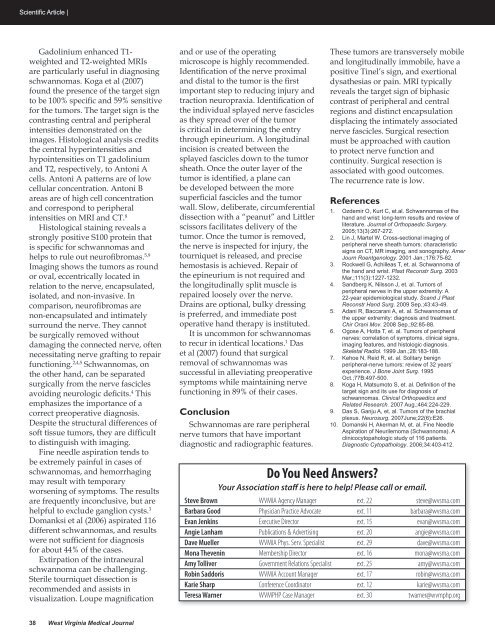March/April - West Virginia State Medical Association
March/April - West Virginia State Medical Association
March/April - West Virginia State Medical Association
- No tags were found...
Create successful ePaper yourself
Turn your PDF publications into a flip-book with our unique Google optimized e-Paper software.
Scientific Article |Gadolinium enhanced T1-weighted and T2-weighted MRIsare particularly useful in diagnosingschwannomas. Koga et al (2007)found the presence of the target signto be 100% specific and 59% sensitivefor the tumors. The target sign is thecontrasting central and peripheralintensities demonstrated on theimages. Histological analysis creditsthe central hyperintensities andhypointensities on T1 gadoliniumand T2, respectively, to Antoni Acells. Antoni A patterns are of lowcellular concentration. Antoni Bareas are of high cell concentrationand correspond to peripheralintensities on MRI and CT. 8Histological staining reveals astrongly positive S100 protein thatis specific for schwannomas andhelps to rule out neurofibromas. 5,9Imaging shows the tumors as roundor oval, eccentrically located inrelation to the nerve, encapsulated,isolated, and non-invasive. Incomparison, neurofibromas arenon-encapsulated and intimatelysurround the nerve. They cannotbe surgically removed withoutdamaging the connected nerve, oftennecessitating nerve grafting to repairfunctioning. 2,4,5 Schwannomas, onthe other hand, can be separatedsurgically from the nerve fasciclesavoiding neurologic deficits. 4 Thisemphasizes the importance of acorrect preoperative diagnosis.Despite the structural differences ofsoft tissue tumors, they are difficultto distinguish with imaging.Fine needle aspiration tends tobe extremely painful in cases ofschwannomas, and hemorrhagingmay result with temporaryworsening of symptoms. The resultsare frequently inconclusive, but arehelpful to exclude ganglion cysts. 3Domanksi et al (2006) aspirated 116different schwannomas, and resultswere not sufficient for diagnosisfor about 44% of the cases.Extirpation of the intraneuralschwannoma can be challenging.Sterile tourniquet dissection isrecommended and assists invisualization. Loupe magnificationand or use of the operatingmicroscope is highly recommended.Identification of the nerve proximaland distal to the tumor is the firstimportant step to reducing injury andtraction neuropraxia. Identification ofthe individual splayed nerve fasciclesas they spread over of the tumoris critical in determining the entrythrough epineurium. A longitudinalincision is created between thesplayed fascicles down to the tumorsheath. Once the outer layer of thetumor is identified, a plane canbe developed between the moresuperficial fascicles and the tumorwall. Slow, deliberate, circumferentialdissection with a “peanut” and Littlerscissors facilitates delivery of thetumor. Once the tumor is removed,the nerve is inspected for injury, thetourniquet is released, and precisehemostasis is achieved. Repair ofthe epineurium is not required andthe longitudinally split muscle isrepaired loosely over the nerve.Drains are optional, bulky dressingis preferred, and immediate postoperative hand therapy is instituted.It is uncommon for schwannomasto recur in identical locations. 1 Daset al (2007) found that surgicalremoval of schwannomas wassuccessful in alleviating preoperativesymptoms while maintaining nervefunctioning in 89% of their cases.ConclusionSchwannomas are rare peripheralnerve tumors that have importantdiagnostic and radiographic features.These tumors are transversely mobileand longitudinally immobile, have apositive Tinel’s sign, and exertionaldysathesias or pain. MRI typicallyreveals the target sign of biphasiccontrast of peripheral and centralregions and distinct encapsulationdisplacing the intimately associatednerve fascicles. Surgical resectionmust be approached with cautionto protect nerve function andcontinuity. Surgical resection isassociated with good outcomes.The recurrence rate is low.References1. Ozdemir O, Kurt C, et.al. Schwannomas of thehand and wrist: long-term results and review ofliterature. Journal of Orthopaedic Surgery.2005;13(3):267-272.2. Lin J, Martel W. Cross-sectional imaging ofperipheral nerve sheath tumors: characteristicsigns on CT, MR imaging, and sonography. AmerJourn Roentgenology. 2001 Jan.;176:75-82.3. Rockwell G, Achilleas T, et. al. Schwannoma ofthe hand and wrist. Plast Reconstr Surg. 2003Mar.;111(3):1227-1232.4. Sandberg K, Nilsson J, et. al. Tumors ofperipheral nerves in the upper extremity: A22-year epidemiological study. Scand J PlastReconstr Hand Surg. 2009 Sep.;43:43-49.5. Adani R, Baccarani A, et. al. Schwannomas ofthe upper extremity: diagnosis and treatment.Chir Orani Mov. 2008 Sep.;92:85-88.6. Ogose A, Hotta T, et. al. Tumors of peripheralnerves: correlation of symptoms, clinical signs,imaging features, and histologic diagnosis.Skeletal Radiol. 1999 Jan.;28:183-188.7. Kehoe N, Reid R, et. al. Solitary benignperipheral-nerve tumors: review of 32 years’experience. J Bone Joint Surg. 1995Oct.;77B:497-500.8. Koga H, Matsumoto S, et. al. Definition of thetarget sign and its use for diagnosis ofschwannomas. Clinical Orthopaedics andRelated Research. 2007 Aug.;464:224-229.9. Das S, Ganju A, et. al. Tumors of the brachialplexus. Neurosurg. 2007June;22(6):E26.10. Domanski H, Akerman M, et. al. Fine NeedleAspiration of Neurilemoma (Schwannoma). Aclinicocytopahologic study of 116 patients.Diagnostic Cytopathology. 2006;34:403-412.Do You Need Answers?Your <strong>Association</strong> staff is here to help! Please call or email.Steve Brown WVMIA Agency Manager ext. 22 steve@wvsma.comBarbara Good Physician Practice Advocate ext. 11 barbara@wvsma.comEvan Jenkins Executive Director ext. 15 evan@wvsma.comAngie Lanham Publications & Advertising ext. 20 angie@wvsma.comDave Mueller WVMIA Phys. Serv. Specialist ext. 29 dave@wvsma.comMona Thevenin Membership Director ext. 16 mona@wvsma.comAmy Tolliver Government Relations Specialist ext. 25 amy@wvsma.comRobin Saddoris WVMIA Account Manager ext. 17 robin@wvsma.comKarie Sharp Conference Coordinator ext. 12 karie@wvsma.comTeresa Warner WVMPHP Case Manager ext. 30 twarner@wvmphp.org38 <strong>West</strong> <strong>Virginia</strong> <strong>Medical</strong> Journal















